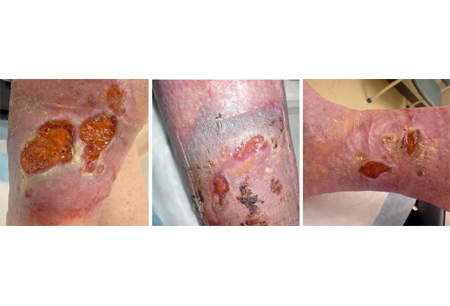Resumo
Definição
História e exame físico
Principais fatores diagnósticos
- presença de fatores de risco
- corona flebectática (exacerbação maleolar ou exacerbação do tornozelo)
- edema maleolar
- hiperpigmentação (edema acastanhado)
- lipodermatoesclerose
- atrofia branca
- úlceras da perna
Outros fatores diagnósticos
- fadiga, dor e/ou desconforto nas pernas
- sensação de peso nas pernas
- cãibras nas pernas
- telangiectasias
- veias reticulares
- veias tortuosas dilatadas
- pele ressecada e escamosa
- queimadura e prurido na pele
- edema unilateral de membro inferior
Fatores de risco
- idade mais avançada
- história familiar
- tabagismo
- trombose venosa profunda
- profissão ortostática
- sexo feminino
- obesidade (circunferência da cintura)
- frouxidão ligamentar
Investigações diagnósticas
Primeiras investigações a serem solicitadas
- ultrassonografia duplex
Investigações a serem consideradas
- flebografia ascendente
- venografia por tomografia computadorizada (TC)
- venografia por ressonância magnética
- TC abdominal e de pelve
- ultrassonografia do abdome e da pelve
- ultrassonografia intravascular
- pletismografia a ar
Treatment algorithm
todos os pacientes sintomáticos
Contributors
Authors
Joseph L. Mills Sr, MD
Professor and Chief
Division of Vascular Surgery and Endovascular Therapy
Michael E. DeBakey Department of Surgery
Baylor College of Medicine
Houston
TX
Disclosures
JLM declares that he has no competing interests.
David G. Armstrong, DPM, MD, PhD
Professor of Surgery
Director of Southwestern Academic Limb Salvage Alliance (SALSA)
Keck School of Medicine of University of Southern California (USC)
Los Angeles
CA
Disclosures
DGA declares that his work is partially supported by grants from the National Institutes of Health and the National Institute of Diabetes and Digestive and Kidney Diseases.
Peer reviewers
Anahita Dua, MD, MS, MBA, FACS
Assistant Professor of Surgery
Massachusetts General Hospital/Harvard Medical School
Boston
MA
Disclosures
AD declares that she has no competing interests.
Paul Tisi, MBBS, MS, FRCSEd
Medical Director/Consultant Vascular Surgeon
Bedford Hospital
Bedford
UK
Disclosures
PT declares that he has no competing interests.
Peer reviewer acknowledgements
BMJ Best Practice topics are updated on a rolling basis in line with developments in evidence and guidance. The peer reviewers listed here have reviewed the content at least once during the history of the topic.
Disclosures
Peer reviewer affiliations and disclosures pertain to the time of the review.
References
Key articles
Lurie F, Passman M, Meisner M, et al. The 2020 update of the CEAP classification system and reporting standards. J Vasc Surg Venous Lymphat Disord. 2020 May;8(3):342-52. Abstract
De Maeseneer MG, Kakkos SK, Aherne T, et al. Editor's choice - European Society for Vascular Surgery (ESVS) 2022 clinical practice guidelines on the management of chronic venous disease of the lower limbs. Eur J Vasc Endovasc Surg. 2022 Feb;63(2):184-267.Full text Abstract
Bergan JJ, Schmid-Schönbein GW, Smith PD, et al. Chronic venous disease. N Engl J Med. 2006 Aug 3;355(5):488-98. Abstract
American Vein and Lymphatic Society (American College of Phlebology). Treatment of superficial venous disease of the lower leg. Feb 2016 [internet publication].Full text
Reference articles
A full list of sources referenced in this topic is available to users with access to all of BMJ Best Practice.

Differentials
- Úlcera do pé diabético
- Úlcera arterial
- Carcinoma de células escamosas (Marjolin)
More DifferentialsGuidelines
- ACR-AIUM-SPR-SRU practice parameter for the performance of peripheral venous ultrasound examination
- ACR appropriateness criteria® lower extremity chronic venous disease
More GuidelinesPatient information
Diabetes do tipo 2: devo tomar insulina?
Insuficiência cardíaca: como posso me ajudar?
More Patient informationLog in or subscribe to access all of BMJ Best Practice
Use of this content is subject to our disclaimer